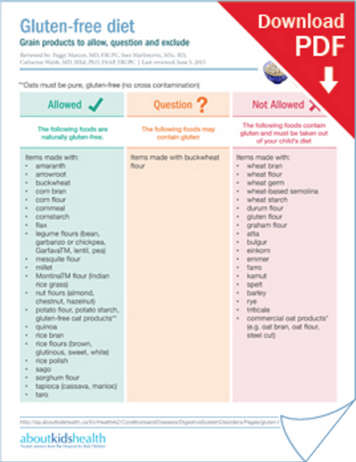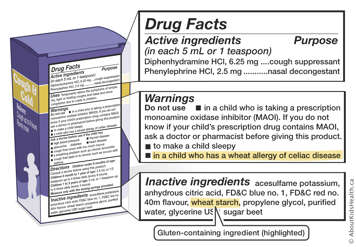
What is celiac disease?
Celiac disease is an autoimmune condition in which contact with gluten (a family of food proteins) triggers a reaction by the body’s defense (immune) system. The immune response to gluten — no matter where in the body the contact happened — damages the lining of the gut (small intestine) making it difficult to absorb nutrients.
Common symptoms of celiac disease include diarrhea, constipation, headaches, tiredness and anemia. Some people experience no symptoms at all.
Celiac disease is a life-long condition. There is no medication for celiac disease. The only treatment is a strict gluten-free diet for life. The gluten-free diet will help heal the gut, improve symptoms that may have been present, and keep your child healthy.
Starting the gluten-free diet
A strict gluten-free diet means no trace amounts of gluten. Gluten is naturally found in all forms of:
- wheat
- rye
- barley
- triticale (rye and barley mix)
Obvious sources of gluten are wheat-based products, such as breads, pasta and baked goods. However, there are also many foods where gluten is hidden, such as soups, salad dressings and ice creams.
Learning to read labels
Always read labels.
Read the labels of all foods and non-food items (such as medications and vitamins) to find out if they contain any sources of gluten.
Though you have been buying the same product for a long time, the ingredients may change without warning. This is why you should read the label of every product every time you shop.

In Canada, if a product is labeled “gluten-free” then it is safe on a strict gluten-free diet. However, food companies in Canada are not required to label a food as gluten-free if it contains no gluten. So, some products may be gluten-free even if not clearly labeled “gluten-free” on the package. An example is sugar.
Every pre-packaged food has an ingredient list on the label. Non-food items have a list that reads “non-medicinal ingredients, “contains” or something similar either on the package or on paper inside the package to read.
Your child
cannot eat a food or use a non-food product if the label says:
- “May contain wheat, barley, rye or triticale.”
- “Is made in a facility that also processes wheat, barley, rye or triticale.”
The only way to make sure a product is gluten-free is if the product is processed in a factory that operates in a gluten-free environment. You can call the company to find out more about gluten exposure of products.
The table below lists:
- Ingredients that are gluten-free (allowed) and acceptable on a gluten-free diet.
- Ingredients that may contain gluten (question). Some foods may contain, be made of, or include, a gluten ingredient such as dextrin. Dextrin can be made from corn (gluten-free) or wheat (not gluten-free).
- Ingredients that contain gluten are not allowed on a strict gluten-free diet.
This list does not include all the possible ingredients in Canada.
If you do not know whether a food is safe, do not eat it until you have contacted the company for more information.
| Allowed | Question | Not allowed |
|---|---|---|
| The following ingredients are naturally gluten-free | The following ingredients may contain gluten | The following ingredients contain gluten and must be taken out of your child's diet |
Amaranth Arrowroot flour Baking soda Buckwheat Cassava (Manioc flour) Chia/ Salba Corn flour/ Cornstarch Dal or Dahl Flavors (artificial & natural) Flax Gelatin Legumes (i.e. lentils, chickpeas) Maltitol Maltose Mannitol Millet Molasses Potato flour and starch Quinoa Rice Sorghum Soy Spices Tapioca flour and starch Teff Vegetable gums Yeast (baking) | Dextrin Hydrolyzed plant protein (HPP) Hydrolyzed vegetable protein Modified food starch Seasonings Starch | Barley
Beer Bran Bulgar Couscous Durum Edible Starch Einkhorn Farina Farro Flour Graham Flour Kamut Malt Oats (exceptions apply; see below) Rye Semolina Spelt (Dinkel) Triticale Wheat (i.e. bran, germ, starch) Yeast (brewer’s) |
Can my child eat oats?
Oats are naturally gluten-free.
During processing, oats can become contaminated with trace amounts of gluten (gluten from one food is passed on to oats) and are no longer gluten-free.
Gluten-free oats are available in Canada. However, your child should wait about one year after being strictly gluten-free before introducing gluten-free oats into their diet. Do not introduce gluten-free oats into your child’s diet until your doctor or dietitian tells you that it is safe to do so.
Once gluten-free oats are in your child’s diet, the Canadian Celiac Association recommends limiting the amount eaten to:
- 20–25 grams per day (1/4 cup dry rolled oats) for children
- 50–70 grams per day (1/2–3/4 cup dry rolled oats) for adults.
When in doubt, ask your doctor or dietitian about gluten-free oats for celiac disease.
Gluten-free shopping
Food products

Gluten is present in many foods. To help you shop safely and easily, you can download the tables from this page. They list foods that contain no gluten (allowed), those to question because they may contain gluten (question), and foods to exclude from your strict gluten-free diet (not allowed). They are organized as follow:
- grain products
- meats and alternatives
- milk and alternatives
- vegetables and fruit
- fats and oils
- snack foods
- desserts and sweets
- other foods
Non-food sources of gluten
Check that these products contain no gluten:
- medications (both prescribed and over the counter); inform your pharmacist about the diagnosis of celiac disease
- vitamins, minerals or other supplements
- products where the label is on the box or bag that the product comes in (for example, a vitamin bottle that comes in a box or Halloween treats where several servings come packaged in a large bag)

Some items that are not meant to be eaten may contain gluten and can trigger a reaction by the immune system. Examples of commonly used products to remove as part of treating celiac disease include gluten-containing:
- hand creams
- lipstick, lip gloss and lip balm
- cosmetics (for example, shampoo, toothpaste, soap)
- play dough
At the grocery store
When grocery shopping, select naturally gluten-free foods, such as fruits and vegetables, plain meat and alternatives and minimally processed dairy. Focus your shopping on the outer areas of the grocery store and less from shelves where you can find many pre-packaged and processed foods.
Some packaged foods are naturally gluten-free (for example plain rice) but will not have a “gluten-free” label so be sure to read the ingredient list of all products to check for sources of gluten.
Look in the health food section of grocery stores to find gluten-free products.
Do not buy foods from bulk bins as they may contain gluten because of cross-contamination.
Maintaining good nutrition while on a gluten-free diet
Compared to gluten-containing foods, most commercially available gluten-free foods are:
- higher in sugar and carbohydrates (very important if you have type 1 diabetes)
- higher in fat
- higher in calories
- lower in fiber
- less fortified
To improve the nutrition of a gluten-free diet, eat:
- more fruits and vegetables
- whole grain gluten-free grains like amaranth, brown rice, buckwheat (kasha), flax and other seeds, millet, quinoa, wild rice
- enriched gluten-free grains (most often enriched with B vitamins)
Vitamins and minerals
Packaged gluten-free foods are often not fortified like gluten-containing grains. Speak to your dietitian or other health-care provider about the need to supplement vitamins and minerals, such as folate and iron.
Vitamin D contributes to bone and immune health. People with autoimmune diseases need to take vitamin D as a supplement.
Children with celiac disease need the following amounts of vitamin D:
- Children younger than six years: 400–600 IU vitamin D3 (cholecalciferol) every day
- Children older than six years: 800–1000 IU vitamin D3 (cholecalciferol) every day.